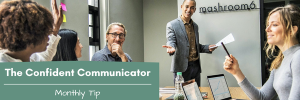People are influenced by real people. That’s one of the secrets that help us connect with our audiences. But what if we don’t possess the charisma of Rita F. Pierson or the stage presence of Steve Jobs?
What we have found in almost two decades of working with presenters — technical and non-technical — is that audiences won’t remember random facts and figures but they will remember a story. Story structure is the great equalizer — regardless of your personal presentation style or comfort level on the stage.
Take Janette Sadik-Khan, for instance. As the Commissioner of the New York City Department of Transportation, she is probably drowning in data. But in her recent TED presentation, Streets of New York Not So Mean Any More, she models three effective uses of story that can help you view your next presentation differently:
1. One Moral to the Story
We often remind our clients that a story has one and only one moral. In presentation speak, this moral or lesson is the presentation’s Core Message or the one key message you want your audience to remember. Sadik-Khan states her core message within 30 seconds and then restates it again to close her presentation.
“You can remake your streets quickly, inexpensively; it can provide immediate benefits, and it can be quite popular. You just need to look at them a little differently.”
Tip: If your audience remembers one and only one thing from your presentation, what do you want it to be? Think bottom line. Then state your core message during your opening and your closing — audiences remember the first and last things we say.
2. Weave Facts and Figures into the Story
People don’t have time to figure out the message behind your data. You need to do that for them by weaving facts and figures into a story. Notice how Sadik-Khan uses numbers creatively to make a compelling case and demonstrate results throughout her presentation.
“We launched City Bike with 6,000 bikes and 330 stations. Since then, 3 Million trips have been taken and people have ridden 7 Million miles. That’s 280 times around the globe.”
Tip: Consider using metaphors and vivid language to turn abstract data into mental images audiences can relate to.
3. Use Visuals that Complement the Story
We often see a good story go wrong when the visuals don’t tell the same story the presenter is telling: Text heavy slides that force audiences to read, not listen, rob your story of the impact it can have.
Notice how Sadik-Khan manages to incorporate a variety of slide styles that illustrate her story, both with high-impact images and with lean fact-and-figures bullet points.
Tip: One common objection to lean slides is: “I have to circulate my slides after the presentation.” Consider these two options: 1) move textual content to the deck’s note pages or 2) circulate the text heavy “reference material” and present from the “visual aid.” And don’t forget: YOU are the most powerful visual aid for your story.
Remember–you don’t need to be a flashy presenter to connect with your audience. Story is the one tool we all have in our presentation toolbox. Make good use of it!
——
Have a high-stakes presentation coming up and you haven’t crystallized the presentation story yet? Invest in yourself with one of our one-on-one coaching programs and get ready to wow your audience.




